January 2020

Real ReproScan Dr. Leslie Harrison
She drives ¾ ton Chevy all over the mountain passes in central Colorado. If only vet trucks could talk! As many of you know, vet trucks are a rolling storyboard. In Dr. Leslies case the truck is the mobile clinic, equipment storage facility, heater, closet, Cora (her trusty sidekick) limo, and many times a teaching or mentoring office. Each scratch or dent represents her kind heart to help those with a passion for vet school, a time when the truck became a true multipurpose tool or a tired oops.
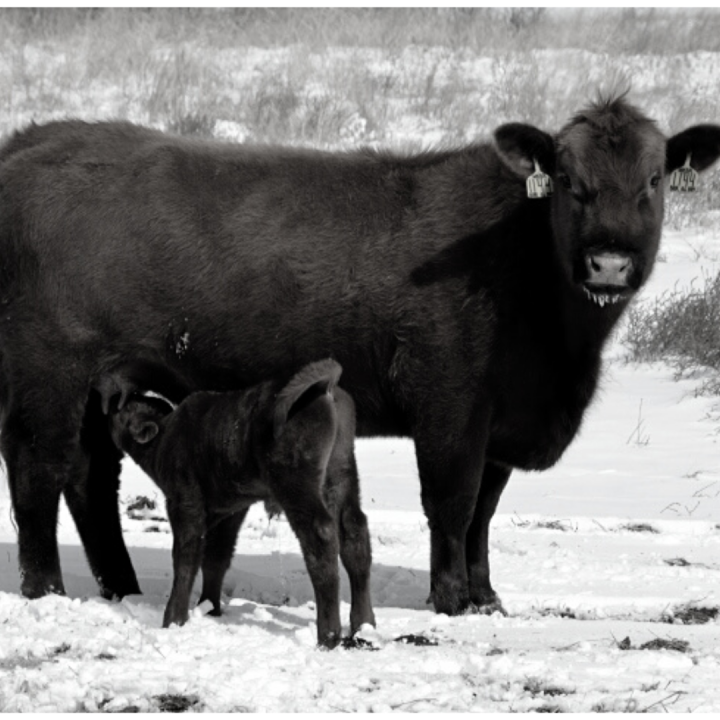
Late Season Pregnancy Checks
As ranchers find innovative ways to reduce winter feed costs such as bale grazing and corn stock grazing, the pregnancy testing season gets extended. When the cows finally get near the corrals for pregnancy testing, the person doing the ultrasound work should be ready for some additional challenges:
Challenges for late season ultrasound scanning include:
1. The weight of the fetus and fetal membranes causes the uterus to drop lower into the abdomen. You will need to insert the ReproArm deeper.

Reproductive Management of Sheep and Goats With ReproScan Equipment
Probe Considerations for Small Ruminants
- C60 3.5 MHz T-handled probe units ReproScan ultrasound equipment with C60 probes are ideal for sheep and goats. The C60 probe gives a depth of scan over 20 cm which is necessary for view the fetus and uterus. The T-handle is comfortable to hold and allows the person to press the probe deep into the inguinal area for better contact and targeted scanning.
- 4.0 MHz convex rectal probe units. ReproScan ultrasound equipment with 4.0 convex rectal probes can be used effectively for sheep and goats. The 4.0 MHz probe gives a depth of scan over 20 cm. The probe is gripped with one’s thumb and index finger and pressed deep into the inguinal area. This probe can be used transrectally as well. Depending on your ultrasound machine and probe type you are able to adjust the setting to give good images while scanning sheep and goats.
October 2019
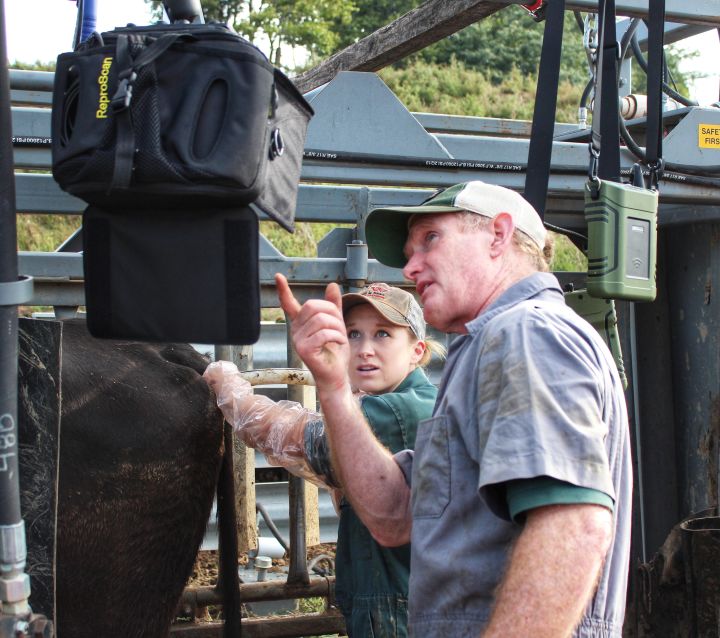
Mounting with Ram Mount® Equipment Mounts
The ReproScan 2.0 Monitor was specifically designed to work with Ram Mount mounting equipment. Clients that adapt the Ram Mounts to their ReproScan equipment are very pleased with the results. The advantages of using the Ram Mount equipment include:
1. The ultrasound unit and monitor are up out of the way and therefore safer.
2. The monitor to be positioned exactly so the image is easy to see and clearer.
3. The monitor is not affected by the wind.
4. Cows entering the chute are not distracted because the equipment is not moving.
5. The monitor and the ultrasound unit stay cleaner.
6. The 3 recommended mounting systems are quite universal.
7. Set up is quick and easy.

Considering Efficiency
The beef industry is built on a platform of efficiency; cow-calf operations, stockers, and feed yards all strive for efficiency. For cow-calf producers, reproductive efficiency is the key to success. Many ranches are currently utilizing ultrasound technology to increase their efficiency. In recent years ultrasound technology has greatly improved, offering simpler and more affordable options for both producers and veterinarians. Producers and veterinarians alike can greatly benefit from the implementation of convex probe extension arm ultrasound technology.
August 2019

Viewing Device Considerations
Monitor versus Goggles for Bovine Reproductive Ultrasound – the debate continues!
Advantages of the ReproScan 2.0 Monitor
Diagnostic Image Quality – The ReproScan 2.0 monitor offers great image quality due to advanced design and internal processing of the ReproScan 2.0 monitor display.
Safety - using a monitor enhances personal safety by improving peripheral vision. Awareness of one’s surroundings should be a goal in everyday life and especially chute-side where too many accidents have occurred in the past.
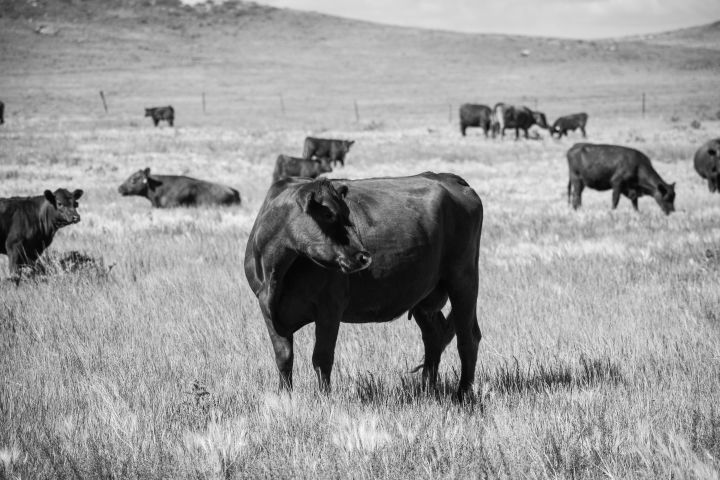
Preg Checking Check List
It’s time to get ready for preg checking season and here is a list of things to consider:
Your ReproScan Equipment:
- Charge your batteries in your XTC or BoviScan Curve and monitor.
- Connect your equipment and turn it on. Ensure that batteries, connectors and cables and chargers are all in good shape.
- Run the equipment for several hours to make sure that your batteries will give you the time you need at the chute. Battery duration should be: XTC 6 hours, BoviScan Curve 8 hours, ReproScan 2.0 monitor 8 hours, Blue Batteries for ReproScan 1.0 monitor 6 hours. If you have less time than this, please make arrangements for a new battery.
Ram Mount Kit
- If you haven’t purchased a Ram Mount kit for mounting your monitor at the chute, now is a good time to get one. This inexpensive equipment works great with ReproScan monitors to safely mount the monitor exactly where you want.
- If you already have a Ram Mount kit, connect the pieces and make sure the parts are all there. Discuss your method of mounting your ReproScan monitor with ReproScan staff to see that you have the Ram Mounts parts that work best with your chute. For example, consider getting a RAM Tough-Claw Large Clamp if you work in tubular chutes. We have had great reviews of this product.
Shorty Arm If you do a lot of short bred cattle, consider ordering a “Shorty” 23” ReproArm. Shorty Arm makes checking heifers at 120 days or less a lot easier in most setups.
July 2019
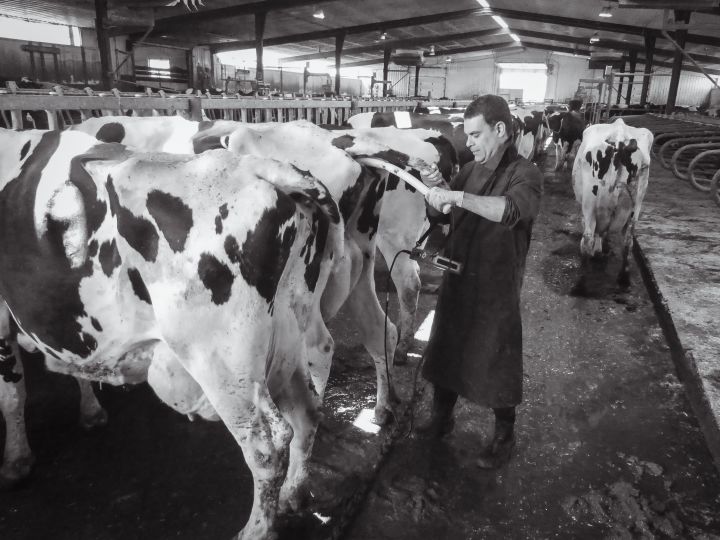
Dairy
ReproScan ultrasound equipment provides solutions for all the challenges of dairy cattle reproductive ultrasound. When selecting ultrasound equipment for dairy cattle reproductive examinations, one needs to consider many factors.
Early Pregnancy Diagnosis
A presumptive diagnosis of pregnancy can be made as early as 25 days. This diagnosis is based on the presence of clear uterine fluid and a functional Corpus Luteum greater than 20 mm on the same side as the fluid. These pregnancies must be recheck as the rate of pregnancy loss at this stage can be quite high. Very early pregnancy testing is usually done with a hand held 6.5 MHz linear rectal probe such as BoviScan HD, BoviScan Linear or ReproScan Flexx (6.5 MHz probe). Pregnancy testing 30 days and up gets considerably easier to do. The heart beat in the embryo can be used confirm the viability of the embryo. The 4.0 MHz convex rectal probe can be used for early pregnancy exams with the “arm in cow” method. The larger field of view makes some examinations easier but there is lower resolution for some procedures. Extension arm ultrasound usually starts at 35 days and up in moderate sized seasonally bred dairy cattle.
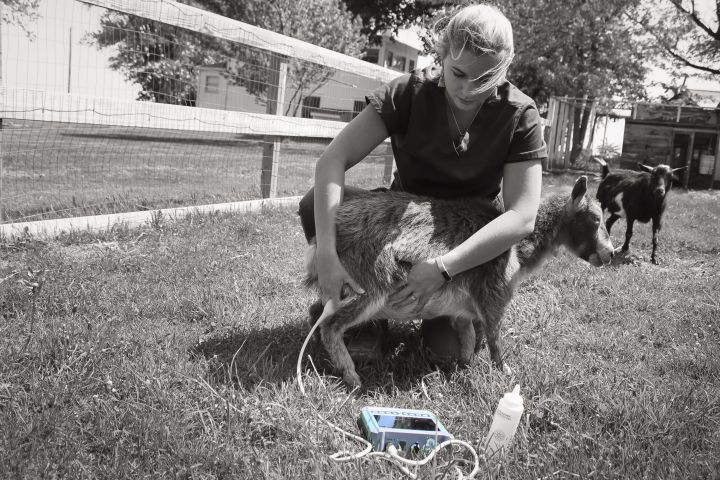
Small Ruminants
Small Ruminants (Camelids, Sheep, Goats, Deer, Elk) Llamas, alpacas, sheep and goats can be pregnancy tested with ultrasound equipment. The best equipment to use will depend on the stage of gestation and the method that you wish to use. Alpacas and llamas can be pregnancy tested with “arm in animal” between 30 and 90 days after breeding similar to a cow if one’s arm is small enough. Extension arm ultrasound can be used in alpacas and llamas.

Equine
Most veterinarians that are doing equine reproduction will want to use the 6.5 MHz linear rectal probe for early pregnancy checks and for scanning and measuring ovaries. Tendons can be examined with the 7.5 MHz L40 probe. The 3.5 MHz C60 convex T handle probe is the probe of choice for equine abdominal exams. If the practice has a 4.0 MHz convex rectal probe, this probe is useful for advanced pregnancy testing in ranch mares.